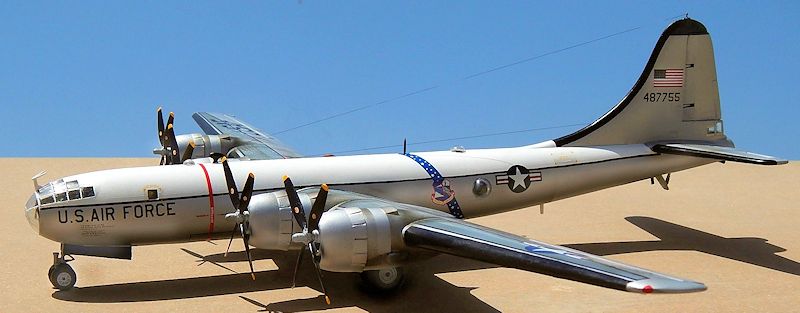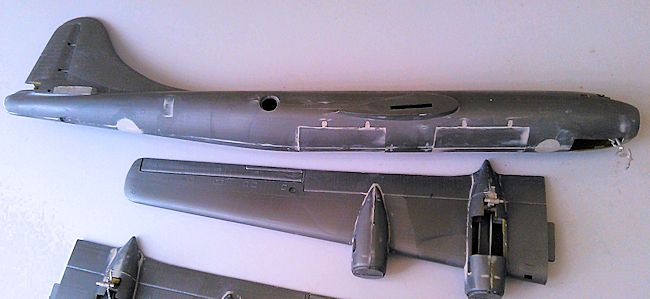
| KIT #: | ? |
| PRICE: | $? |
| DECALS: | ? |
| REVIEWER: | Carmel J. Attard |
| NOTES: | Simple conversion |

| HISTORY |
 The combat status of the B-29 was an impressive one. The first deployment
overseas of the type was at
Kwanghan in China on 24th of April 1944 in one of the freshly
prepared 4 airfields by Chinese workmen. The first raid was carried out on
Bangkok, Thailand on the 5th of June 1944. This was followed 10 days
later when 50 B-29s attacked the first target on the Japanese mainland hitting
steel mills in Yawata, with loss of 7 aircraft only one of which attributed to
enemy action.
The combat status of the B-29 was an impressive one. The first deployment
overseas of the type was at
Kwanghan in China on 24th of April 1944 in one of the freshly
prepared 4 airfields by Chinese workmen. The first raid was carried out on
Bangkok, Thailand on the 5th of June 1944. This was followed 10 days
later when 50 B-29s attacked the first target on the Japanese mainland hitting
steel mills in Yawata, with loss of 7 aircraft only one of which attributed to
enemy action.
Following that no less than 180 B-29s went on each bases on recaptured Mariana
Islands., 3 bases on Guam, 2 on Tinian and one on Saipan. The first raids from
the Marianas was on 24th December 1944 when 111 B-29s made the 3,000
mile round trip to hit the Musahino engine factory. The B-29s then gained fame
for their fire raids with incendary bombs causing such devastation to highly
flammable Japanese style of house building. Firebombs like the M-69 was an
incendary cluster containing a jelly gasoline compound was developed for such
raids. Two weeks later followed targets on Tokyo, Nagoya, Osaka and Kobe which
inflected extensive damage.The Americans then landed on Okinawa for the final
and last battle.
The long endurance raids called for a special air-sea rescue service for downed
crew. B-29s were converted to carry airborne lifeboats for this role. The B-29
years later made its next debut over Korea with bombing strikes during which it
had to defend itself from Russian made jets, the MiG
15s.
Other variants of the B-29s continued to evlove which included the KB-29M and
KB-29P in flight refuelling roles which led the way to present day methow of
refuelling. Another variant that evolved from the B-29 was the F-13, a photo
reconnaissance aircraft with special camera installations plus standard
bombing equipment.
 Following
the end of the Korean War, the B-29 was rapidly retired from service. The last
of the USAF's B-29 bombers had been replaced by B-47s by 1954. The KB-29M and
KB-29P tankers were all replaced by the KC-97 by 1957. However, a few B-29s were
converted to specialized missions and soldiered on for several more years.
Sixteen were converted into SB-29 search and rescue aircraft, which carried an
A-3 lifeboat underneath the fuselage. Others were modified for weather
reconnaissance under the designation WB-29. A few were converted to TB-29 target
towing and radar evaluation aircraft, and some became QB-29 target drones. There
was even a stripped cargo B-29, the CB-29K.
The VB-29 was a VIP transport. The
last B-29 (a TB-29 radar evaluation aircraft, serial number 42-65234) was
retired from the USAF inventory on June 21, 1960, bringing the era of
Superfortress service to an end. However, it seems that a few B-29s were still
serving as inflight-refueling tankers as late as 1963.
Following
the end of the Korean War, the B-29 was rapidly retired from service. The last
of the USAF's B-29 bombers had been replaced by B-47s by 1954. The KB-29M and
KB-29P tankers were all replaced by the KC-97 by 1957. However, a few B-29s were
converted to specialized missions and soldiered on for several more years.
Sixteen were converted into SB-29 search and rescue aircraft, which carried an
A-3 lifeboat underneath the fuselage. Others were modified for weather
reconnaissance under the designation WB-29. A few were converted to TB-29 target
towing and radar evaluation aircraft, and some became QB-29 target drones. There
was even a stripped cargo B-29, the CB-29K.
The VB-29 was a VIP transport. The
last B-29 (a TB-29 radar evaluation aircraft, serial number 42-65234) was
retired from the USAF inventory on June 21, 1960, bringing the era of
Superfortress service to an end. However, it seems that a few B-29s were still
serving as inflight-refueling tankers as late as 1963.
| THE KIT |
 The Airfix basic kit of the B-29 was used for the conversion into a VB-29
Superfortress which in this form the Superfortress was adopted for long range
VIP transport attached to 3rd Air Division, SAC during 1954-55. The
kit comes in a sizeable box and comes complete with top and lower gun turrets
and a complete bomb load that fits inside the two tandem bomb bays. Fit of parts
was good considering that the kit appeared in shops for the first time some 45
years ago.
The Airfix basic kit of the B-29 was used for the conversion into a VB-29
Superfortress which in this form the Superfortress was adopted for long range
VIP transport attached to 3rd Air Division, SAC during 1954-55. The
kit comes in a sizeable box and comes complete with top and lower gun turrets
and a complete bomb load that fits inside the two tandem bomb bays. Fit of parts
was good considering that the kit appeared in shops for the first time some 45
years ago.
| CONSTRUCTION |
 at other kit for such a conversion.
at other kit for such a conversion.
The kit construction from now on followed the Airfix kit instructions. Cockpit
floor, instruments, crew seats, control wheels and bulk heads assembled in their
respective place. I had no detail of the VIP passenger compartment which should
go aft of the cockpit bulkhead and behind the pilot seats but even so, none of
this detail could be visible from the outside once the fuselage halves are
joined together. Crew compartment and fuselage interiors were painted cockpit
green and crew seats in dark brown. A crew seat at the far end of the fuselage
was added, this was made from plastic card. The wings were sub assembled, adding
some structural detail to the wheel wells that appeared bare as supplied. This
was in the form of cross channels made from strips of plastic card. Fit of
engines and nacelles to wings was reasonable requiring little filler at mating
parts. Added weight to a closed compartment behind the nose wheel well. Bay
doors were closed permanently.
| COLORS & MARKINGS |
 Decal markings for the VB-29 were picked from Xtradecal sheet X032-72. This
72-scale sheet also had markings for a WB-50D and a KB-29P. A sheet intended for
the big Boeings enthusiast. The model had all fuselage top in white otherwise
overall natural metal including fin and rudder. A fuselage cheat line insignia
blue separated the fuselage white and silver finish. De-icing black boots
painted to wings, tail plane and fin leading edges. The tail fin top and nose
wheel doors were blue FS 15102. Propellers are flat black with yellow tips and
the wing walkways were light dull silver grey.
Decal markings for the VB-29 were picked from Xtradecal sheet X032-72. This
72-scale sheet also had markings for a WB-50D and a KB-29P. A sheet intended for
the big Boeings enthusiast. The model had all fuselage top in white otherwise
overall natural metal including fin and rudder. A fuselage cheat line insignia
blue separated the fuselage white and silver finish. De-icing black boots
painted to wings, tail plane and fin leading edges. The tail fin top and nose
wheel doors were blue FS 15102. Propellers are flat black with yellow tips and
the wing walkways were light dull silver grey.
| CONCLUSIONS |
If you would like your product reviewed fairly and fairly quickly, please contact the editor or see other details in the Note to Contributors.